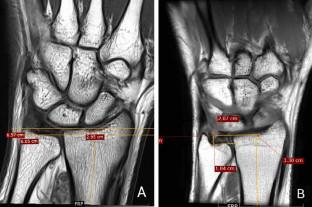Indian Journal of Orthopaedics ( IF 1.1 ) Pub Date : 2022-08-16 , DOI: 10.1007/s43465-022-00717-1 Prashant Kamble 1 , Sameer Panchal 2 , Rudra Prabhu 3 , Himanshu Choudhury 4 , Shubhranshu S Mohanty 1

|
Background
Ulnar variance (UV) is the variation of the level of the distal articulating surface of the radius with respect to the distal articulating surface of the ulna. These variations either positive or negative can predispose to pathologies involving the wrist joint. The aim of this study was to measure the ulnar variance in a subset of Indian population using high-resolution MRI and compare our results with the existing literature.
Materials and Methods
Retrospective analysis of 100 normal wrist MRIs were done performed during November 2020 to November 2021 and the ulnar variance was calculated using the Method of Perpendiculars. All the MRI sequences were performed by an experienced radiologist with prior fixed protocol for the study. The measurements were done on the mid-coronal section based on the Method of Perpendiculars using Meddiff Rispacs software.
Results
The average age of the participants was 42 years, with Male to female ratio of 0.9:1. 47 MRIs were of the left wrist, while 53 MRIs were of the right wrist. The mean UV was − 0.7 mm (SD-0.175), ranging from − 4.5 mm to 3.5 mm. There was a significant relationship between ulnar-variance and age, as ulnar-variance increases with the age (p value = 0.039). There was no statistically significant correlation of ulnar-variance with gender distribution and handedness.
Conclusions
This study utilized high-resolution MRI for measuring ulnar-variance in a subset of Indian population and disclosed that the ulnar-variance affirms a positive correlation with age, while no specific pattern between the ulnar-variance and gender or handedness could be established.
Graphical abstract
中文翻译:

使用高分辨率 MRI 进行尺骨变异及其人口动态的形态测量分析:印度人口的回顾性研究和文献综述
背景
尺骨方差(UV)是桡骨远端关节表面相对于尺骨远端关节表面的水平变化。这些积极或消极的变化都可能导致涉及腕关节的病变。本研究的目的是使用高分辨率 MRI 测量印度人口子集的尺骨方差,并将我们的结果与现有文献进行比较。
材料和方法
对2020年11月至2021年11月期间的100例正常腕部MRI进行回顾性分析,并使用垂直法计算尺骨方差。所有 MRI 序列均由经验丰富的放射科医生按照事先固定的研究方案进行。测量是使用 Meddiff Rispacs 软件根据垂直法在中冠状切片上进行的。
结果
参与者平均年龄42岁,男女比例为0.9:1。47 次 MRI 是左手腕的,53 次 MRI 是右手腕的。平均 UV 为 − 0.7 毫米 (SD-0.175),范围为 − 4.5 毫米至 3.5 毫米。尺骨方差与年龄之间存在显着关系,因为尺骨方差随着年龄的增长而增加(p值 = 0.039)。尺骨变异与性别分布和利手习惯没有统计学上显着的相关性。
结论
这项研究利用高分辨率 MRI 测量印度人口子集的尺骨变异,并揭示尺骨变异与年龄呈正相关,但无法建立尺骨变异与性别或惯用手之间的特定模式。











































 京公网安备 11010802027423号
京公网安备 11010802027423号